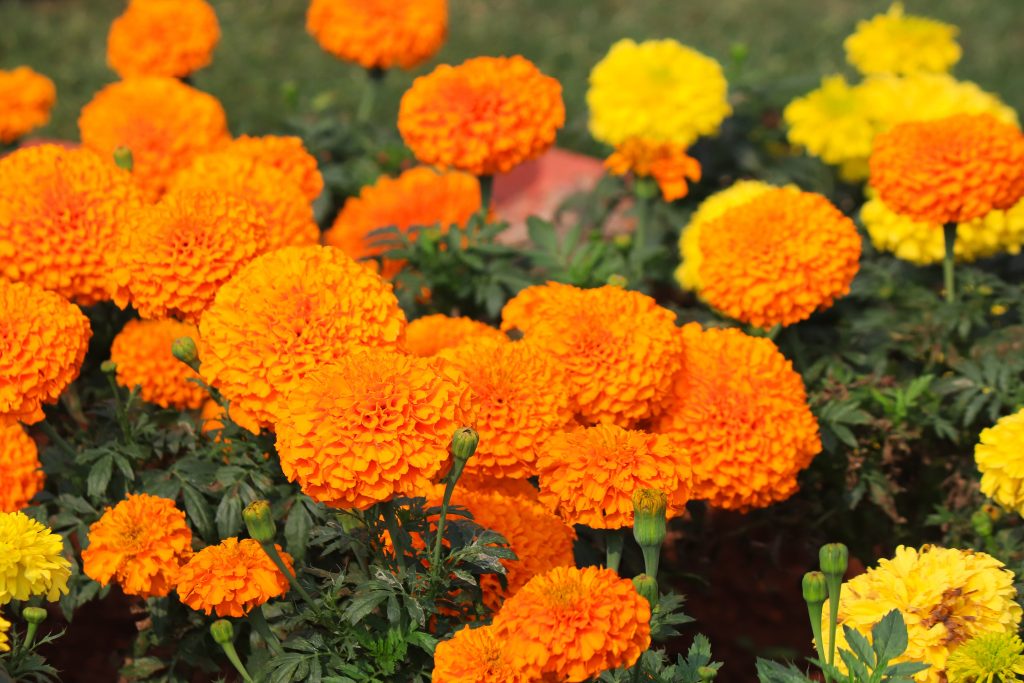
Marigolds are easy to grow and care for, making them a popular choice for many gardeners. Here are some general steps to follow to grow marigold flowers: Choose a suitable location: Marigolds prefer full sun to partial shade and well-drained soil. Select a location that receives at least six hours of direct sunlight per day.
Plant the seeds: Marigold seeds can be sown directly into the soil or started indoors and transplanted. If sowing directly, plant the seeds about 1/4 inch deep and 1 inch apart. If starting indoors, sow the seeds in seed-starting trays filled with potting soil and keep them in a warm, sunny location until they germinate.
Water regularly: Keep the soil moist but not waterlogged. Water the marigolds deeply once a week or more frequently in hot, dry weather.
Fertilize as needed: Marigolds do not require heavy fertilization, but you can apply a balanced fertilizer once or twice during the growing season to promote healthy growth.
Control pests: Marigolds are generally resistant to pests and diseases, but you may encounter problems with aphids, spider mites, or slugs. Use organic pest control methods, such as insecticidal soap or neem oil, to keep these pests under control.
Deadhead spent flowers: Pinch off the spent blooms to encourage more flowers to grow and to prevent the plant from going to seed.
Enjoy the blooms: Marigolds typically bloom from mid-summer until the first frost. You can cut the flowers for indoor arrangements or simply enjoy them in the garden.
How to Grow MariGold?
Marigolds are a popular annual flower that are easy to grow and provide bright and cheerful blooms all summer long. Here’s a guide on how to grow marigolds:
- Choose a planting location: Marigolds prefer full sun and well-draining soil. They can tolerate some shade, but may not flower as well.
- Plant seeds: Marigold seeds can be sown directly into the ground after the last frost date in your area. Alternatively, you can start seeds indoors 4-6 weeks before the last frost date and transplant them outside after the danger of frost has passed. Sow seeds 1/4 inch deep and 2-3 inches apart.
- Water regularly: Keep the soil moist but not waterlogged until the seeds have germinated. Once the plants are established, marigolds are drought-tolerant and don’t require frequent watering.
- Fertilize: Marigolds don’t require heavy fertilization, but a light application of a balanced fertilizer (such as 10-10-10) once a month can help promote healthy growth and blooming.
- Deadhead regularly: Deadheading (removing spent flowers) encourages the plant to produce more blooms and prolongs the blooming season.
- Mulch: Adding a layer of mulch around the base of the plants can help conserve moisture and suppress weeds.
- Pest and disease control: Marigolds are generally pest and disease-resistant, but can sometimes be affected by aphids or spider mites. If necessary, treat with insecticidal soap or a neem oil-based insecticide.
By following these simple steps, you can grow beautiful marigold flowers that will add color and cheer to your garden. Marigolds are also known for their ability to repel certain pests, such as nematodes and whiteflies, making them a great addition to vegetable gardens as well.

It is not that much of a internet reader to be honest but your blogs really nice, keep it up! I’ll go ahead and bookmark your website to come back down the road. All the best